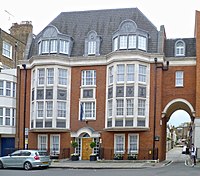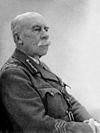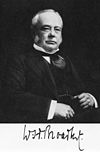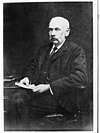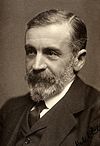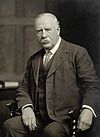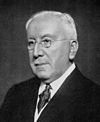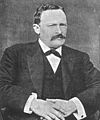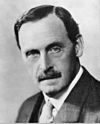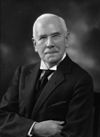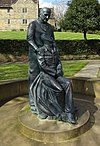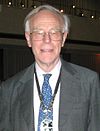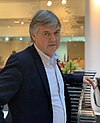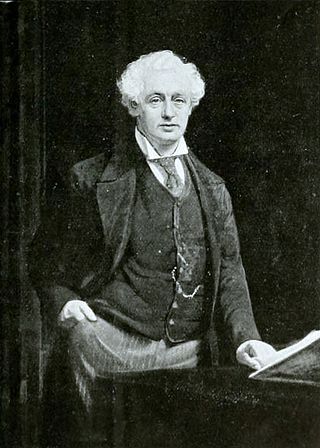
Thomas Pickering Pick was a British surgeon and author. He edited the tenth through fourteenth editions of Gray's Anatomy, succeeding Timothy Holmes as editor. His other notable books include Fractures and Dislocations, A Treatise on Surgery (1875), and Surgery (1899).

Sir Ernest Donald Acheson was a British physician and epidemiologist who served as Chief Medical Officer of the United Kingdom from 1983 to 1991. He was born in Belfast, Northern Ireland.

King Edward VII's Hospital is a private hospital located on Beaumont Street in the Marylebone district of central London.
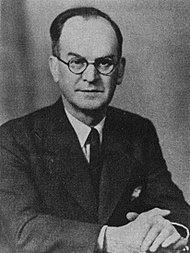
Sir Clement Price Thomas was a pioneering Welsh thoracic surgeon most famous for his 1951 operation on King George VI.

Lancelot Edward Barrington-Ward KCVO, FRCS, FRCSEd was a British surgeon who won four rugby union international caps for England shortly after graduating in medicine at the University of Edinburgh. He worked as a paediatric surgeon at the Hospital for Sick Children, Great Ormond Street, London, and as a general surgeon at the Royal Northern Hospital, London. He was appointed surgeon to the Royal Household by King George VI and was made a Knight Commander of the Royal Victorian Order (KCVO) in 1935.

Arthur Tudor Edwards was a Welsh thoracic surgeon, who worked at the Westminster Hospital, the Royal Brompton Hospital and Queen Mary's Hospital, Roehampton and pioneered lung surgery, in particularly pulmonary tuberculosis and lung tumours.

Ian Aird was a Scottish surgeon who became Professor of Surgery at the Royal Postgraduate Medical School in London. There he built up a large and productive research department which made particular contributions in cardiac surgery, renal transplantation and the association of blood groups with stomach cancer. He came to national and international prominence in 1953 when he led the teams which performed an operation to separate conjoined twins. His book A Companion in Surgical Studies was among the best selling surgical textbooks of its day. He died suddenly in 1962 at the age of 57.

Sir Thomas Longmore was Surgeon-General and professor of military surgery at the Army Medical School at Netley Hospital. Prior to this appointment, he had a long and distinguished career as a military doctor and surgeon, notably serving during every major engagement of the Crimean War, even while suffering from frostbite.
Patrick Stewart Boulter FRCS, FRCSEd was a general surgeon in Guildford, England. He developed a sub-speciality interest in breast surgery and was one of the pioneers in the UK of screening for breast cancer. He served as president of the Royal College of Surgeons of Edinburgh from 1991 to 1994.

Sir James Dundas-Grant KBE, MD, FRCSEd, FRCS was a British ear, nose and throat surgeon. He was surgeon to a number of London hospitals and surgeon to several institutions. He was regarded as a prolific writer about a variety of topics within his speciality and devised a number of surgical instruments. In addition to his clinical practice he was president of several surgical speciality societies and was knighted in 1920.

John Percy Lockhart-Mummery FRCS, was a British surgeon at St Mark's Hospital, London, who devised a classification of rectal cancer and described familial polyposis which led to the formation of the polyposis registry. He was the author of several books, including Diseases of the Rectum and Colon and their Surgical Treatment (1923) and The Origin of Cancer (1934). His work on colorectal surgery earned him the nickname "King Rectum".
Sir Hugh Evelyn Lockhart-Mummery, KVCO,, was a British surgeon who researched inflammatory bowel disease and distinguished Crohn's from colitis. He was educated at Sandroyd School and Stowe School. He was Serjeant-Surgeon to The Queen.

Alice Saxby MVO was a British nurse who was matron to King Edward VII's Hospital for Officers, London, from 1948 to 1969. She was previously in charge of an officer's wing at Botleys Mansion during the Second World War and cared for many casualties from the Normandy landings.
Sir Arnold Lawson, was a British ophthalmologist. During the First World War he was on the list of honorary consultants at King Edward VII's Hospital for Officers, drawn up by Sister Agnes in 1914. He was responsible for blinded servicemen at St Dunstan's Hospital for Blinded Soldiers and Sailors.
Sir Thomas Crisp English, born Thomas Johnston English, KCMG was a British surgeon at St George's Hospital, and consulting surgeon to Queen Alexandra Military Hospital, Millbank, the Royal Hospital Chelsea, and to King Edward VII's Hospital for Officers.
Charles Arthur Morris (1860–1942), was a British surgeon to the King Edward VII's Hospital for Officers during the Boer War in South Africa. In 1914 he was on the list of honorary medical staff at the hospital, compiled by Sister Agnes, with whom he was good friends, and served at the hospital during the First World War.
Sir Frederic William Hewitt M.V.O.,, was an anaesthetist at the London Hospital for 15 years and later to King Edward VII. In 1904 he was listed an honorary member of staff of the King Edward VII's Hospital.
Lieutenant-Colonel Herbert Herbert, FRCS was a British ophthalmologist and officer in the Indian Medical Service (IMS), known for his work on trachoma, cataract and glaucoma. Later, he was vice-president of the Ophthalmological Society of the UK.

